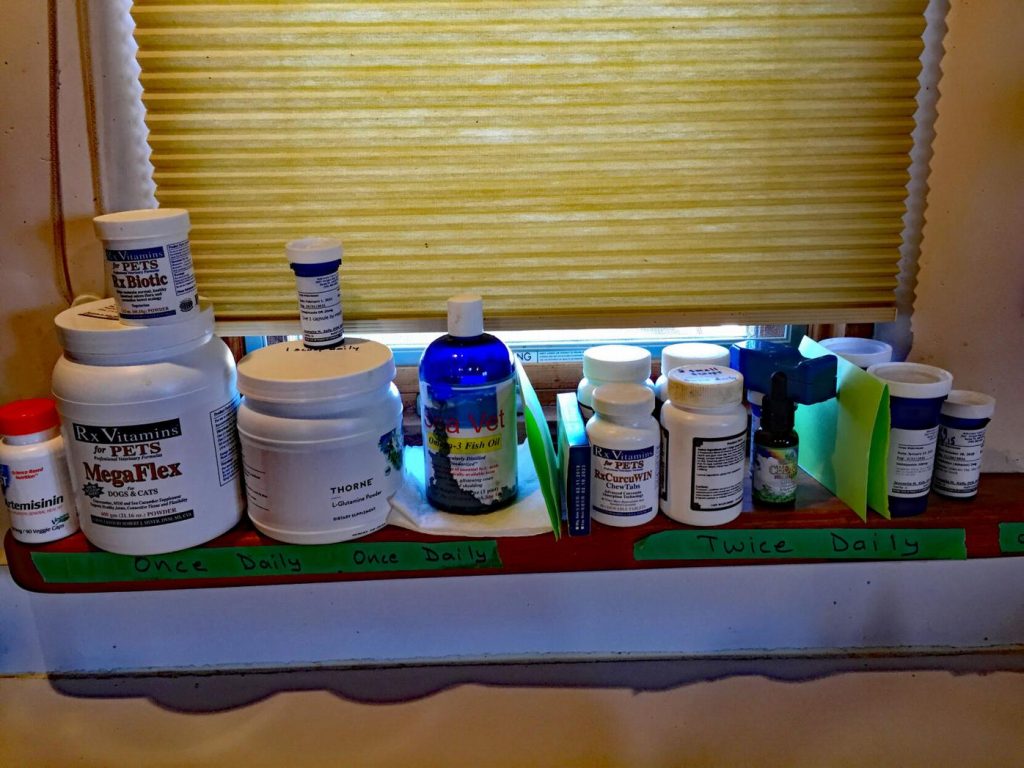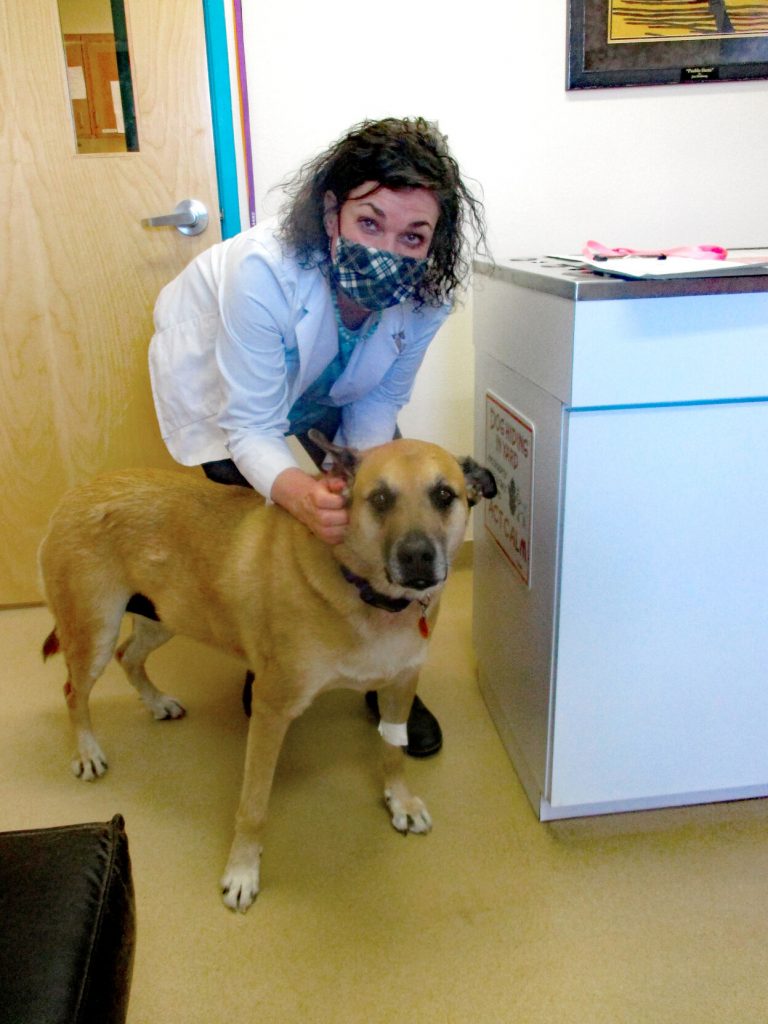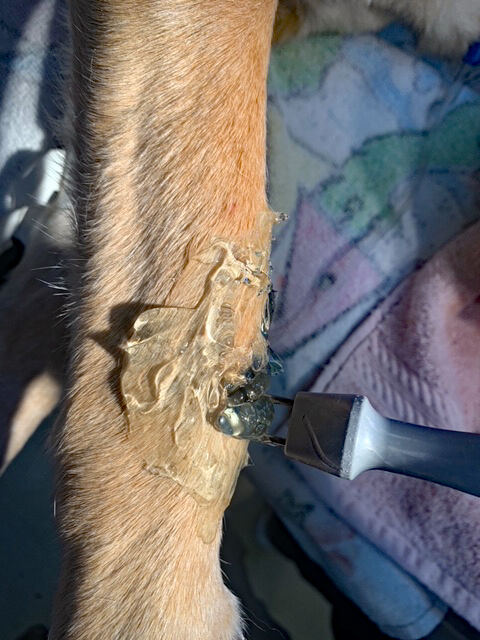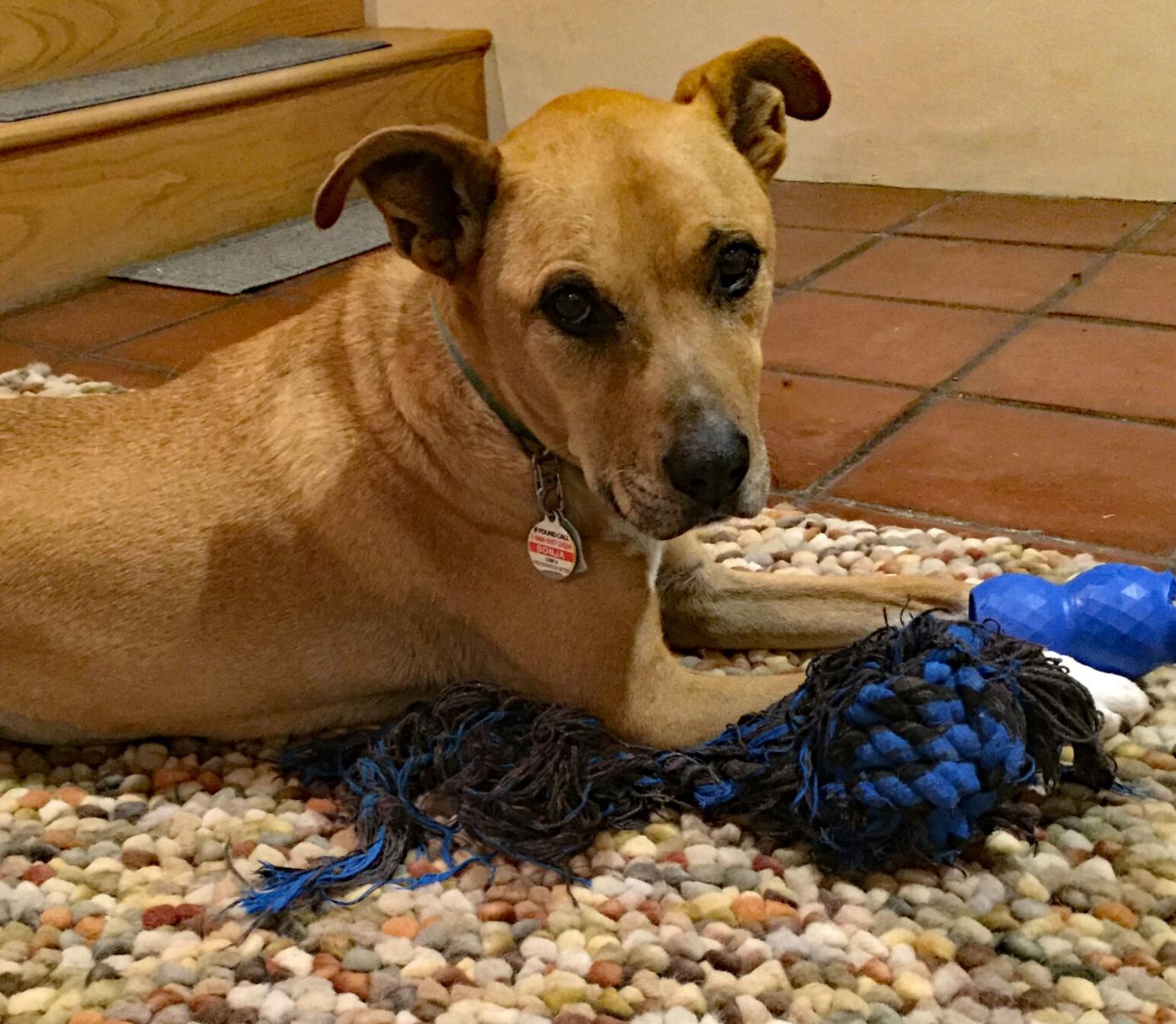Hope for dogs with cancer
One morning in January, my dog Dennis started to limp. He held up his right paw to show me something was wrong. I wasn’t too concerned at first, as he often steps on a thorn or rock and limps for a few days. But after a week, the limp didn’t improve so I made an appointment with Dr. Tim Johnson at Johnson Veterinary Clinic.
Thinking it might be arthritis since Dennis will be 10 years old this summer, Johnson prescribed some anti-inflammatory and pain relief medication. Although the medication seemed to help a little, Dennis continued to limp and be in obvious pain.
An X-ray was the next step. Johnson warned me that the X-ray might show that the problem was bone cancer – a disease that is generally fatal. The morning after Valentine’s Day, I took Dennis into the office. Johnson gave him an anesthetic in order to perform the procedure. When I came back several hours later, Johnson showed me the X-ray that told the story I didn’t want to hear. The bone above Dennis’s right foot looked “moth-eaten” as Johnson described it. The area was light in contrast to the dense bone around it, a marker of bone cancer.
Quite often, by the time bone cancer in animals is discovered, it has spread to the organs and is quickly fatal. In any case, the usual treatment is amputation followed by chemotherapy. Johnson recommended against amputation for Dennis, given that he is a large 100 pound dog.
Alternatives
I spent a bleak week watching Dennis walk less and less. One day, he stopped eating, which worried me as I knew that can be a sign of the end of life. Turns out he had colitis, an inflammation of the colon, perhaps from one of the medications he had been taking. I spoke to Johnson who advised discontinuing the medication and gradually Dennis began to eat again.
The picture improved the following week when I had an initial phone consultation with Dr. Jeannette Kelly, DVM at Veterinary Cancer Care in Santa Fe. She let me know there are some alternative treatments for bone cancer that looked promising. As I reviewed their website, I saw her practice had been part of several clinical trials exploring new approaches to cancer in dogs.

When asked about the typical approach to bone cancer in animals, Veterinatry Cancer Care Senior Oncology Nurse and Operations Manager Megan Padget said “Amputation is still a standard of care. Unfortunately, this is not an option for all patients for a variety of reasons, including cost, patient weight, patient size, location of the cancer (for instance the front leg) and client concerns. Amputation is effective in treating pain, because is removes the tumor which is the cause of the pain. However, osteosarcoma has a high likelihood of pulmonary metastasis [spreading to the lungs], so it does not necessarily mean you have beaten the cancer. Bone-sparing surgery that removes part of the bone can also be effective in alleviating pain, yet we see a high incidence of the surgery site breaking down leading to a need for wound management, which can be expensive over time and result in more pain for the pet.”
Veterinary Cancer Care visit
At the end of February, Dennis and I made the two-hour drive to the office of Veterinary Cancer Care in Santa Fe. It’s a friendly, cage-free environment and several dogs roamed the halls, including Dr. Kelly’s dogs: Great Dane Dakota and pit bull mix Kai.
The first step was to do another X-ray to confirm the diagnosis and an ultrasound to see if the cancer spread into the organs of the body. Blood was taken to check for imbalances and vitamin deficiencies. Before this step was performed, the staff presented the pricing for approval.
The ultrasound showed no signs that the cancer had spread – a tremendous relief. After a discussion of options, the staff proceeded with two treatments.
The first was Zoledronate, which is administered intravenously. It is a bisphosphonate, a drug used to prevent the loss of bone density.

“Zoledronate pulls calcium from the blood and directs it to the bone,” Padget explained. “This helps rebuild the bone that has been destroyed by the cancer as well as alleviate bone pain. This is a great treatment option when amputation is not chosen.”
The other treatment was electrochemotherapy, which is a way of giving chemotherapy in tiny dosages using electric probes. It slows the growth of the cancer and usually makes the area feel better within a day or two. ” electrochemotherapy is becoming more popular in the United States, but has been popular in Europe for a while. It provides a more gentle and cost effective alternative to radiation,” said Padget.
The results
To my amazement and relief, the next day Dennis was better. He began putting weight on his right paw and walking around the yard more. Within a few days, we resumed doing parts of one of our regular hikes and he seemed to be in less pain.
We will return about once a month to Veterinary Cancer Care to monitor his progress and continue treatments.
Supplements and food
When we left the clinic, we took a variety of supplements home, including powders, pills and liquids that reduce pain, slow cancer and support overall health.
We also took with us a hand-out called “An Easy Guide to Canine Nutrition.” Among the recommended approaches are home cooking or special diets for better nutrition. The hand-out describes the type of food a dog needs on a daily basis with 75 to 88 percent of it being protein with organ meats and 10 to 20 percent of the diet being fruits and vegetables with carbohydrates at less than 10 percent.
One way to approach to this type of feeding is to order pre-prepared meals from a place like Marty’s Meals in Santa Fe. They offer raw and gently cooked meals along with bones and other food that provide high quality non-GMO meat that is organic when possible. There is a special gently cooked cancer diet developed by a vet that includes boar, sweet potatoes, mushrooms, flax and other ingredients. Marty’s Meals can ship the frozen food to Taos.
When asked about which is more important, treatments, supplements or food, Padget said, “Each does have a role. Bone cancer has a high rate of pulmonary metastasis. Anecdotally, we see a slower rate of progression to the lungs when we use integrative methods. Keeping the whole pet’s body as healthy as possible, parts such as their immune system, skin, muscles and GI tract, help them to fight the cancer more effectively.”
Sonja – the miracle dog
Eight months ago, Ruth Waterhouse noticed her dog Sonja was limping. Waterhouse is a longtime Taos resident and former co-owner of the Alley Cantina. She has volunteered at Stray Hearts where she met Sonja, and now volunteers at the Equine Spirit Sanctuary. Waterhouse estimates that Sonja is about 10 years old and from genetic testing knows that she is half American Staffordshire Terrier, a quarter boxer and a mix of other breeds.
When Sonja saw a local vet, the problem was diagnosed as arthritis. Waterhouse took Sonja to an arthritis specialist in Colorado and a different diagnosis emerged: bone cancer in the shoulder and sacral area. “It was during COVID and I was waiting outside when they called me from the clinic and told me the diagnosis. The vet offered to put Sonja down immediately. I said, ‘My dog will go home with me.’ I was really down,” said Waterhouse.

After her return to Taos, Waterhouse found Dr. Heather Fox, a mobile vet who offers some Eastern approaches like herbs and acupuncture. Fox recommended Waterhouse contact Veterinary Cancer Care.
“At first, we were going to see Dr. Kelly in Santa Fe every week for treatments including chemotherapy and Zoledronate,” said Waterhouse. “Now we go about every four weeks. Sonja’s lab work has stayed stable and her enlarged lymph nodes have shrunk 70 percent. I never asked Dr. Kelly about life expectancy for Sonja, but after a few months, she started to call Sonja the miracle dog.”
One concern is the cost of treatment. Waterhouse worries about the ongoing costs of the treatments, supplements and special diet for Sonja and others in the same situation.
Cost considerations
For X-rays, ultrasound, electrochemotherapy and Zoledronate treatment, along with a bag of supplements, my first visit was expensive, like most medical treatments. The staff does their best to help people find approaches that fit their budget.
“No one is turned away,” said Dr. Kelly. “We try to find less expensive alternatives for those who need them.” Front office manager Blair Bolz explained that only about 10 percent of their clients have pet insurance. The clinic staff works with people to set up payment plans and provide applications for CareCredit, which allows people to pay over time and also directs them to grant programs available for pet care.
The supplements and special meals also add cost, although places like Marty’s Meals work with people to find affordable alternatives like buying high quality meat in bulk or mixing their meals with kibble.
The future
Today, Sonja plays with her toys and has a good life with Waterhouse. Although she limps occasionally, she is in good health overall. In addition to the treatments with Dr. Kelly, Sonja takes about 15 different vitamins and supplements and gets a special diet that emphasizes protein. Waterhouse makes bone broth for Sonja and continues to work with Dr. Fox, who Waterhouse says is an invaluable part of the team. “The way I think about it now is that we didn’t set out to cure cancer, but to manage it. The goal has been to keep her comfortable and happy,” said Waterhouse.
Sonja’s ongoing heath is a source of inspiration for me, as I manage the trips for treatment, the supplements and food, the costs and most of all the worry about the health of my best friend for the last nine years.
For more information
To find out more about Veterinary Cancer Care, visit vetcancercare.com or call 505-982-4492. Marty’s Meals website is martysmeals.com or call 505-467-8162. Locally, Unleashed carries food from Marty’s Meals. Call ahead to see what they have in stock, 575-613-7344.
Source: TaosNews. By Cindy Brown
Support families fighting financial toxicity of cancer –here
